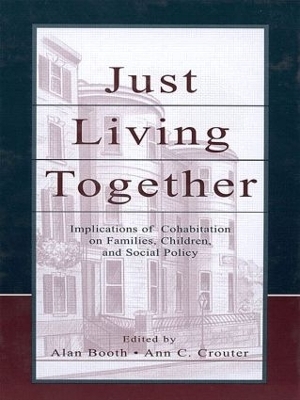
Just Living Together
Routledge (Verlag)
978-1-138-00368-2 (ISBN)
- Titel ist leider vergriffen;
keine Neuauflage - Artikel merken
Based on the presentations and discussions from a national symposia, Just Living Together represents one of the first systematic efforts to focus on cohabitation. The book is divided into four parts, each dealing with a different aspect of cohabitation. Part I addresses the big picture question, "What are the historical and cross cultural foundations of cohabitation?" Part II focuses specifically on North America and asks, "What is the role of cohabitation in contemporary North American family structure?" Part III turns the focus to the question, "What is the long- and short-term impact of cohabitation on child well-being?" Part IV addresses how cohabiting couples are affected by current policies and what policy innovations could be introduced to support these couples.
Providing a road map for future research, program development, and policymaking. Just Living Together will serve as an important resource for people interested in learning about variations in the ways families of today are choosing to organize themselves.
Contents: Preface. Part I: What Are the Historical and Cross-Cultural Foundations of Cohabitation?K. Kiernan, Cohabitation in Western Europe: Trends, Issues, and Implications. N.S. Landale, Contemporary Cohabitation: Food for Thought. A.G. Hunter, (Re)Envisioning Cohabitation: A Commentary on Race, History, and Culture. Part II: What Is the Role of Cohabitation in Contemporary North American Family Structure?P.J. Smock, S. Gupta, Cohabitation in Contemporary North America. R. Jayakody, N. Cabrera, What Are the Choices for Low-Income Families?: Cohabitation, Marriage, and Remaining Single. R.L. Coley, What Mothers Teach, What Daughters Learn: Gender Mistrust and Self-Sufficiency Among Low-Income Women. C. Le Bourdais, H. Juby, The Impact of Cohabitation on the Family Life Course in Contemporary North America: Insights From Across the Border. Part III: What Is the Long- and Short-Term Impact of Cohabitation on Child Well-Being?W.D. Manning, The Implications of Cohabitation for Children's Well-Being. A. Kalil, Cohabitation and Child Development. B.J. Ellis, Of Fathers and Pheromones: Implications of Cohabitation for Daughters' Pubertal Timing. S.L. Brown, Child Well-Being in Cohabiting Families. Part IV: How Are Cohabitating Couples and Their Children Affected by Current Policies? What Policies Are Needed for These Individuals?W.E. Primus, J. Beeson, Safety Net Programs, Marriage, and Cohabitation. R. Haskins, Federal Social Policy, Cohabitation, and Marriage. A.E. Winkler, The Complexity of Tax and Transfer Program Rules Regarding Cohabitation: Challenges and Implications. M.M. Mahoney, The Economic Rights and Responsibilities of Unmarried Cohabitants. L.F. Hoelter, D.E. Stauffer, What Does It Mean to Be "Just Living Together" in the New Millennium? An Overview.
| Erscheint lt. Verlag | 15.8.2014 |
|---|---|
| Reihe/Serie | Penn State University Family Issues Symposia Series |
| Verlagsort | London |
| Sprache | englisch |
| Themenwelt | Geisteswissenschaften ► Psychologie ► Familien- / Systemische Therapie |
| Geisteswissenschaften ► Psychologie ► Sozialpsychologie | |
| ISBN-10 | 1-138-00368-9 / 1138003689 |
| ISBN-13 | 978-1-138-00368-2 / 9781138003682 |
| Zustand | Neuware |
| Haben Sie eine Frage zum Produkt? |
aus dem Bereich


